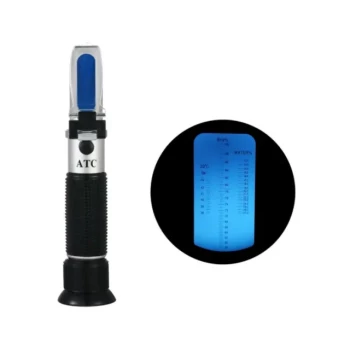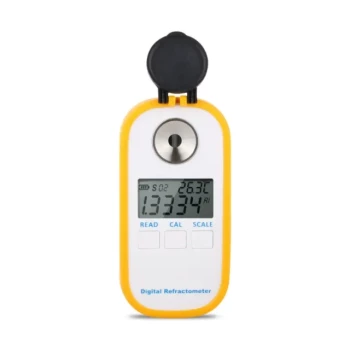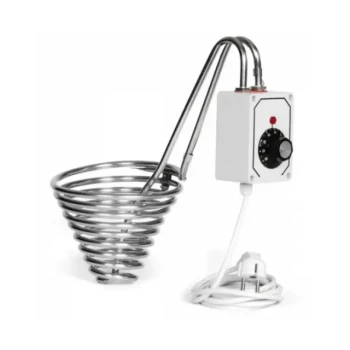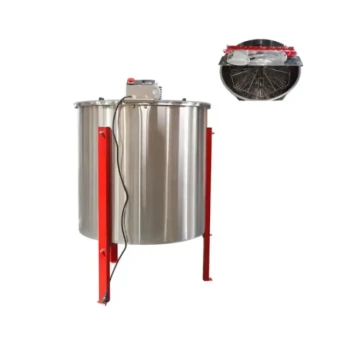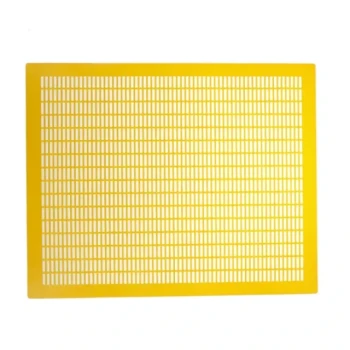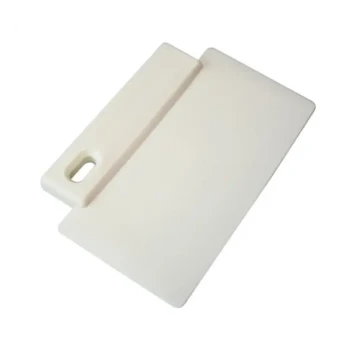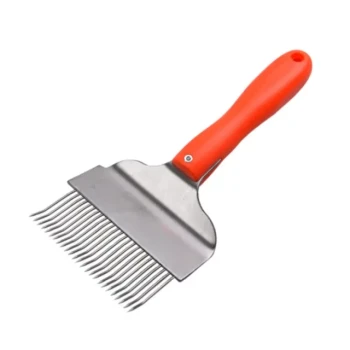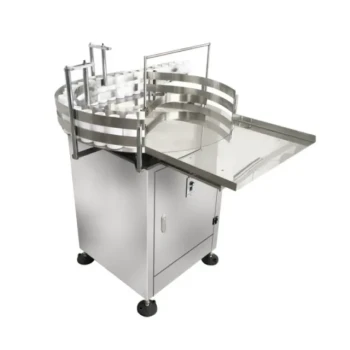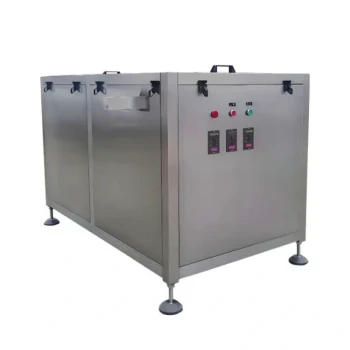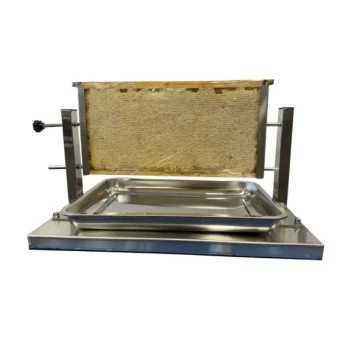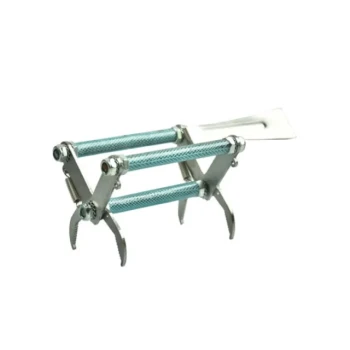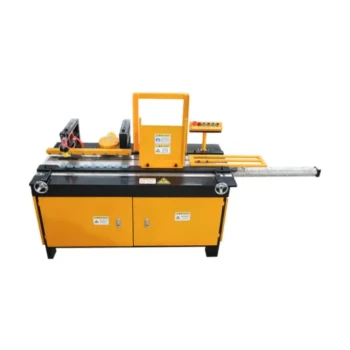In the world of commercial beekeeping, consistency and quality are not just goals; they are requirements. The moisture content of your honey is the single most critical factor determining its grade, stability, and market value. Honey with moisture exceeding the industry standard (typically 18.6%) is at high risk of fermentation, which can ruin an entire batch, damage your brand's reputation, and result in significant financial loss.
Your most important ally in controlling this variable is the honey refractometer. But this tool is only as good as its last calibration. An inaccurate refractometer provides a false sense of security, potentially leading you to bottle honey that is destined to spoil.
This guide provides the professional standard for calibrating both analog and digital honey refractometers, ensuring every reading you take is one you can trust.
The Cardinal Rule: Why You Must Never Use Water
Let's address the most common and costly mistake first: do not calibrate a honey refractometer with distilled water.
Standard refractometers (for fruit juice or coolants) are designed for simple sucrose solutions and are correctly calibrated to a zero-point using water. Honey refractometers, however, are built with a specific scale that accounts for the complex sugar profile of honey, which is rich in fructose. Calibrating with water will introduce a systemic error, causing your instrument to read moisture content approximately 1.5% lower than the true value. This error margin is more than enough to turn a profitable harvest into a fermented liability.
For accurate calibration, you must use a liquid with a known, stable refractive index that corresponds to a specific point on the honey moisture scale. The best options are:
- Diopter Oil (or Clove Oil): This is the industry gold standard. It is exceptionally stable and provides a precise, known reading. The target value is always printed on the bottle, but it is typically around 19.6% moisture.
- Pure Glycerin (Glycerol): A widely available and highly effective alternative. Pure glycerin will consistently read at approximately 21.5% moisture on a properly calibrated honey refractometer.
- Extra Virgin Olive Oil: A reliable and convenient option found in most kitchens. Good quality, pure extra virgin olive oil gives a consistent reading at or very near 27.0% moisture.
Calibrating the Workhorse: The Analog Refractometer
The traditional analog refractometer is the dependable tool found in countless honey houses. Its reliability is rooted in its simple, robust design and clear optics.
The HONESTBEE Professional Analog Refractometer
At HONESTBEE, we supply tools built for the demands of a working apiary. Our Professional Analog Honey Refractometer is a cornerstone of our equipment line, prized by commercial beekeepers for its:
- Rugged Construction: A full metal body that withstands the bumps and drops of a busy honey house.
- Sharp, High-Contrast Optics: An easy-to-read scale that minimizes ambiguity and speeds up readings.
- Automatic Temperature Compensation (ATC): A crucial feature that ensures accuracy in real-world conditions (10-30°C / 50-86°F), eliminating the need for manual temperature correction charts.
It is the trusted, manual tool for everyday quality control.
Step-by-Step Calibration Process:
- Prepare the Surface: Lift the daylight plate (the hinged cover). Using a clean, lint-free cloth, thoroughly wipe the glass prism and the underside of the plate. Any residue will compromise the reading.
- Apply Calibration Fluid: Using a pipette, place 1-2 drops of your chosen fluid (e.g., diopter oil) onto the center of the dry prism.
- Close the Plate: Gently lower the daylight plate, allowing the fluid to spread evenly without air bubbles. If bubbles appear, lift the plate, clean, and re-apply.
- Acclimate Temperature: Wait 30-60 seconds. This allows the fluid's temperature to stabilize with the refractometer's prism, which is essential for the ATC feature to function correctly.
- View and Focus: Hold the refractometer towards a natural light source and look into the eyepiece. You will see a scale divided by a boundary line (blue on top, white on bottom). Turn the eyepiece ring to bring this line and the scale into sharp focus.
- Adjust to the Mark: Read the value where the boundary line crosses the "Water %" scale. If using extra virgin olive oil, this line should be exactly on 27.0%. If it's off, remove the small rubber cap from the calibration screw (usually on top). Use the small screwdriver to slowly turn the screw until the line is perfectly aligned with the correct mark.
- Verify and Clean: Wipe the prism and plate clean. Repeat the process once more without adjusting the screw to confirm the calibration is stable. Your instrument is now ready for accurate use.
Calibrating for Speed and Certainty: The Digital Refractometer
For high-throughput operations where speed and the elimination of any user error are paramount, a digital refractometer is the superior choice.
The HONESTBEE Digital Honey Refractometer
For our clients who need ultimate precision and efficiency, HONESTBEE offers our Digital Honey Refractometer. This instrument is designed for the modern commercial operation:
- Push-Button Simplicity: Reduces a multi-step process to a few seconds.
- Error-Free Readout: A clear, backlit LCD screen displays the exact moisture percentage, eliminating any chance of misreading a scale.
- High Accuracy: Precise digital sensors deliver repeatable, trustworthy results batch after batch.
- Durable and Easy to Clean: Features a stainless steel sample well that is both tough and simple to wipe clean.
It is the ideal tool for ensuring absolute quality control in large-scale extraction and packing facilities.
Step-by-Step Calibration Process:
- Prepare the Well: Ensure the stainless steel sample well and the glass sensor at the bottom are perfectly clean and dry.
- Enter Calibration Mode: Turn the device on. Press the "CAL" or "ZERO" button to prepare the unit for calibration. The display will typically prompt you to add your calibration standard.
- Apply Calibration Fluid: Place several drops of your chosen fluid (e.g., glycerin) into the well, making sure the sensor is completely covered.
- Perform Calibration: Press the "CAL" or "READ" button again. The device will measure the fluid, automatically adjust its internal scale, and then display the result.
- Confirm the Reading: The screen should display the correct value for your fluid (e.g., ~21.5% for glycerin). If it does, calibration is complete.
- Clean Thoroughly: Use a soft cloth to wipe the sample well clean. Your digital refractometer is now calibrated and ready for rapid, accurate measurements.
Final Word: Your Tools Define Your Product
Calibration is not a chore; it is a fundamental process of professional quality assurance. By taking these few minutes to ensure your instruments are accurate, you are actively protecting your honey, your brand, and your business's bottom line.
At HONESTBEE, we are committed to supplying the robust, reliable, and precise tools that commercial beekeepers and distributors depend on.
Contact our wholesale team today to receive our full catalog and learn how HONESTBEE can equip your operation for success.
Visual Guide
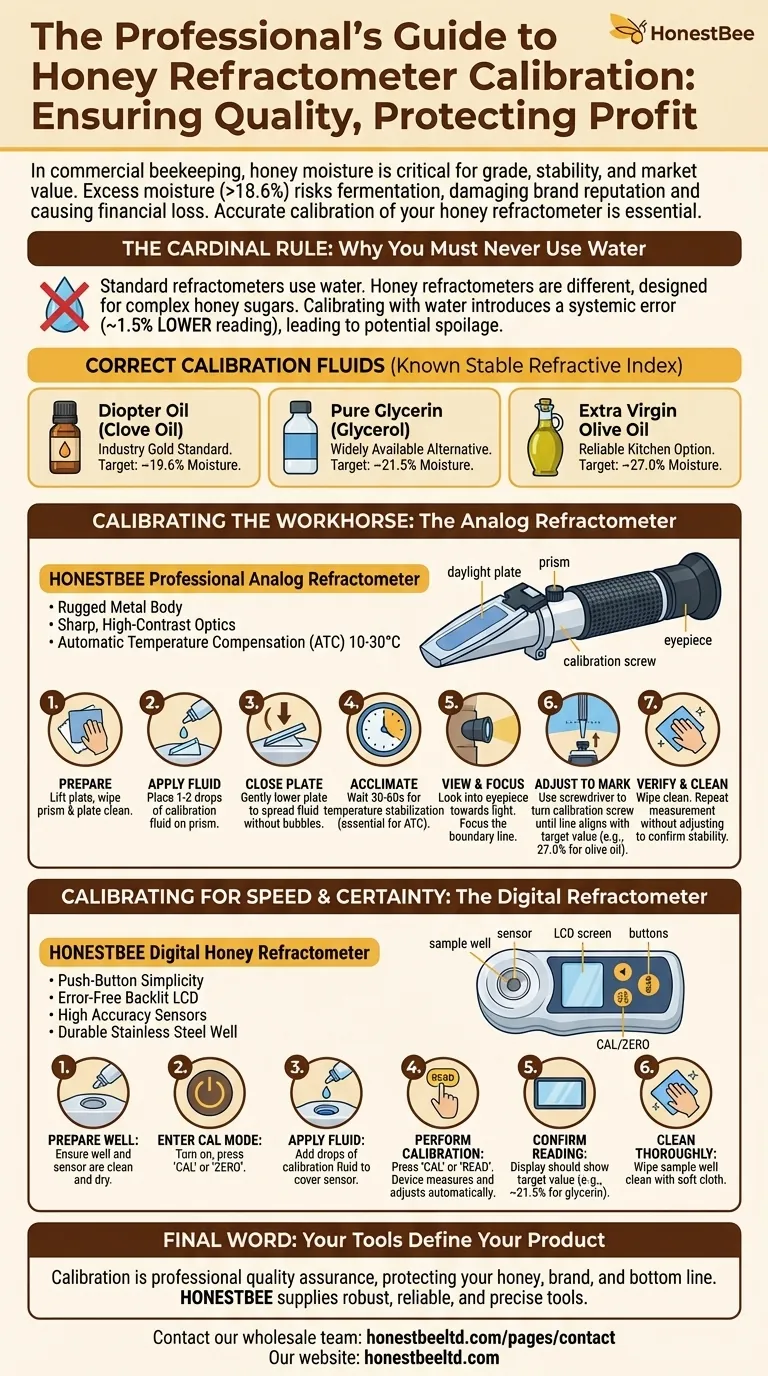
Related Products
- Precision Honey Refractometer Instrument for Quality Assessment
- Digital Honey Refractometer for Precision Measurement of Optimal Honey Quality
- Professional Thermostatic Conical Honey Melter
- Honey Concentrating Vacuum Heating Thickening Machine Dehumidifier for Honey
- HONESTBEE 3-Frame Manual Acrylic Honey Extractor
Related Articles
- How to Reduce Honey Moisture: Science-Backed Methods for Beekeepers
- How Beekeepers Prevent Honey Spoilage Through Perfect Harvest Timing
- How to Prevent Honey Fermentation: The Science of Moisture Control for Beekeepers
- How to Control Honey Moisture Content: Science-Backed Methods for Beekeepers
- Mastering the Craft: A Professional's Guide to Calibrating Your Honey Refractometer



